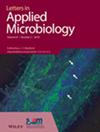In vitro efficacy of aquaculture antimicrobials and genetic determinants of resistance in bacterial isolates from tropical aquaculture disease outbreaks.
IF 2
4区 生物学
Q3 BIOTECHNOLOGY & APPLIED MICROBIOLOGY
引用次数: 0
Abstract
Understanding the efficacy of antimicrobials against pathogens from clinical samples is critical for their responsible use. The manuscript presents in vitro efficacy and antimicrobial resistance (AMR) genes in seven species of fish pathogens from the disease outbreaks of Indian aquaculture against oxytetracycline, florfenicol, oxolinic acid, and enrofloxacin. In vitro efficacy was evaluated by minimum inhibitory concentration and minimum bactericidal concentration. The gene-specific PCR screened AMR genes against quinolones (qnrA, qnrB and qnrS) and tetracyclines (tetM, tetS, tetA, tetC, tetB, tetD, tetE, tetH, tetJ, tetG, and tetY). The results showed that Aeromonas veronii (45%) showed the maximum resistance phenotype followed by Streptococcus agalactiae (40%), Photobacterium damselae (15%), Vibrio parahaemolyticus (10%), and Vibrio vulnificus (5%). There was no resistance among Vibrio harveyi and Vibrio alginolyticus against the tested antimicrobials. The positive association between tetA, tetB, tetC, tetM, or a combination of these genes to oxytetracycline resistance and qnrS to quinolone resistance indicated their potential in surveillance studies. The prevalence of resistance phenotypes (16.43%) and evaluated AMR genes (2.65%) against aquaculture antimicrobials was low. The resistance phenotype pattern abundance was 0.143. All the isolates showed susceptibility to florfenicol. The results help with the appropriate drug selection against each species in aquaculture practices.水产养殖抗菌剂的体外药效和热带水产养殖疾病爆发中细菌分离物的抗药性遗传决定因素。
从临床样本中了解抗菌素对病原体的疗效对于负责任地使用抗菌素至关重要。该手稿介绍了印度水产养殖中暴发的七种鱼类病原体对土霉素、氟苯尼考、草酸和恩诺沙星的体外药效和抗菌药耐药性(AMR)基因。体外药效通过最小抑菌浓度和最小杀菌浓度进行评估。基因特异性 PCR 筛选了针对喹诺酮类(qnrA、qnrB 和 qnrS)和四环素类(tetM、tetS、tetA、tetC、tetB、tetD、tetE、tetH、tetJ、tetG 和 tetY)的 AMR 基因。结果显示,维罗尼单胞菌(45%)表现出最大的抗药性表型,其次是无乳链球菌(40%)、光杆菌(15%)、副溶血性弧菌(10%)和弧菌(5%)。哈维弧菌和藻溶弧菌对测试的抗菌素没有抗药性。tetA、tetB、tetC、tetM 或这些基因的组合与土霉素耐药性呈正相关,qnrS 与喹诺酮耐药性呈正相关,这表明它们在监测研究中具有潜力。水产养殖抗菌素的耐药性表型(16.43%)和评估的 AMR 基因(2.65%)的流行率较低。耐药性表型丰度为 0.143。所有分离菌株都对氟苯尼考有敏感性。这些结果有助于在水产养殖实践中针对每种鱼类选择适当的药物。
本文章由计算机程序翻译,如有差异,请以英文原文为准。
求助全文
约1分钟内获得全文
求助全文
来源期刊

Letters in Applied Microbiology
工程技术-生物工程与应用微生物
CiteScore
4.40
自引率
4.20%
发文量
225
审稿时长
3.3 months
期刊介绍:
Journal of & Letters in Applied Microbiology are two of the flagship research journals of the Society for Applied Microbiology (SfAM). For more than 75 years they have been publishing top quality research and reviews in the broad field of applied microbiology. The journals are provided to all SfAM members as well as having a global online readership totalling more than 500,000 downloads per year in more than 200 countries. Submitting authors can expect fast decision and publication times, averaging 33 days to first decision and 34 days from acceptance to online publication. There are no page charges.
 求助内容:
求助内容: 应助结果提醒方式:
应助结果提醒方式:


